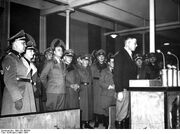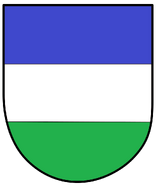
Meeting of a local Selbstschutzverband
The Selbstschutzverband (Luthoran: Self protection association) is a branch of the Volksdundorfische Cultural Association for former and current military members, they are a major proponent of Pan-Dundorfianism and were founded by Ulrich Maria zu Völksau, a Dorvish noble in 1907. The Seblstschutverband are direct descendants of the Freikorps movement in the 18th-century, gradually as the Freikorps members came more and more involved with the VDKV the VDKV absorbed them and finally in 1907 Ulrich Maria zu Völksau was appointed to create a paramilitary to fight for the Volksdundorfische, at home and abroad.
The first non-Artanian Selbstschutzverband was organized of Volksdundorfische in Al'Badara as a pre-emptive "fifth column" to the eventual Badaran Protectorate. Between agreement between the Volksdundorfische Cultural Association's Head Selbsschutzverband Office a 6th "Selbsschutzverband" formed underneath the name of the Free Majatran Legion (Dundorfian: Legion "Freies Majatrien") the formation was agreed upon by the al-Sadhi Organization and the VDKV.
History[]
TEST
Militant culture[]
A large majority of the Selbstschutzverband were former military members of the Dundorfian Reichsheer, they eventually came to join the Selbstschutzverband because it offered a means of fraternity. The self protection units were originally established as paramilitary organizations to fight against rising national governments as the Dundorfian Reich collapsed underneath the weight of self-determination of national cultures during the 20th century. This lead to the self protection units to arm themselves as well as develop a highly centralized rank structure (which would later be borrowed by several nationalistic Dundorfian, Dorvish and other Volksdundorfische political parties) and a sometimes xenophobic culture. The Volksdundorfische Cultural Association has attempted to shed this image of a militant organization but the self protection units in Kirlawa continue to take this image with them wherever they go.
The recent development by the VDKVs leadership to fund the Free Majatran Legion has raised questions if the VDKV is preparing for further influence in areas where Volksdundorfians live.
Politics[]
The Selbstschutzverband were initially established by wealthy financiers in the Dundorfian Reich, this lead to the self protection units being closely associated with the conservative ideals of the Dundorfian Reich. In the nationalist and conservative fervor of the 19th century in Artania the self protection units reflected this, they were heavily influenced by the conservative ideals of their founders and they retrain much of that till this day. The Dorvish, Kirlawan and Rutania self protection units are nationalist and conservative, with the Kirlawan being the conservative and militarist; they are often called fascist by enemies traditionally on the right. The Dorvish and Rutanian, while militaristic toe the nationalist more than the ultra conservative line and do not espouse the traditional xenophobia that the Kirlawan branch of the self protection units do.
The Ikradonian and Alorian self protection units were established by socialist and communist financiers, thus they tend to be more left-wing, however it should be noted that some political experts today state that they have meshed ideas (between socialist and fascist) and become a single, reactionary group. The Ikradonian self protection unit collapsed while the Alorian self protection units remains relatively weak compared to the Rutanian and Kirlawan self protection units there were established.
Organization[]
The Selbstschutzverband only earned its rigid organization in 1907 underneath the direction of Ulrich Maria zu Völksau who thought it would be a disgrace to use the Reichsheer titles and organization and instead worked his staff on creating new ranks and finally towards the end of 1907 the Self-Protection Grand Council approved the structure and appointed Ulrich Maria zu Völksau as the first SS-Oberstgruppenführer.
The Selbstschutzverband, alongside their associates in the VDKV political branches, make use of a variety of uniforms which replicate very closely to old style Dundorfian military uniforms, they however use different colors. Members of the SSV also wear an arm patch on their left arm that bears the mark of which Oberabschnitt that they come from. Those members of the SSV or VDKV who come from Dorvik or Dundorf do not wear patches on their arm because the country is governed by Volksdundorfische. Members of the Free Majatran Legion, an active military unit of the SSV likewise wears a patch on their left arm.
- SS-Oberabschnitt (Lead District) - The national-sized unit of the non-combat SS comprised whatever SS-Abschnitt existed under it and these vary in strength and size throughout Artania. They are led by a SS-Gruppenführer or a SS-Obergruppenführer and had the largest of a headquarters staff alongside a musical company, logistics company, cooking company, security company and a dedicated transportation platoon.
- SS-Abschnitt (District) - The district-sized unit of the non-combat SS comprised of the Standarte under it, these range in number and strength throughout Artania. The SS-Abschnitt has a sizable headquarters staff alongside a musical platoon, logistics platoon, cooking platoon,security platoon and a transportation squad. The Abschnitt are led by a SS-Oberführer or a SS-Brigadeführer. SS-Abschnitt are traditionally found on the state/region level.
- SS-Standarte (Regiment) - The primary unit of the non-combat SS comprised of one thousand one hundred twenty or more SS members including a headquarters staff, musical squad, logistics squad and a cooking platoon. The SS-Standarte is headed by a SS-Standartenführer. The Standarte are number sequentially based on its founding. The Standarte are typically found on county/district level.
- SS-Sturmbann (Battalion/Storm Unit) - Unit comprised of five hundred sixty or more SS members including a headquarters staff with a SS-Sturmbannführer or SS-Obersturmbannführer at its head. the SS-Sturmbann is traditionally found in major cities.
- SS-Sturm (Company) - Unit comprised of sixty-nine to one hundred ninety SS members including the SS-Untersturmführer or SS-Obersturmführer as its leader.
- SS-Trupp (Troop/Platoon) - Unit comprised of forty to fifty-two SS members including the SS-Oberscharführer or SS-Hauptscharführer as its leader.
- SS-Schar (Squad) - Unit comprised of ten to fifteen SS members including the SS-Unterscharführer as its leader.
- SS-Rotte (Section) - Unit comprised of four to five SS members including the SS-Rottenführer as its leader.





